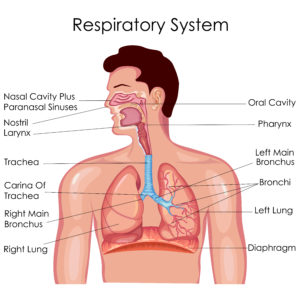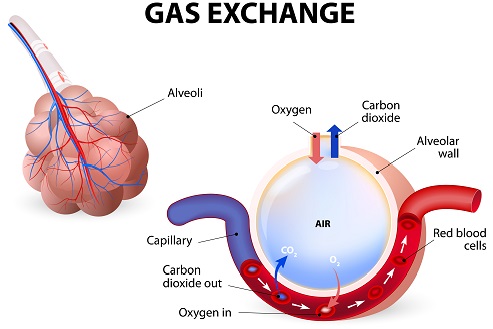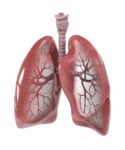 The function of the respiratory system is not only the intake of oxygen into the body but also the removal of carbon dioxide out of the body. This process is called Gas Exchange. Oxygen is vital for our survival, and carbon dioxide is toxic to the human body in large quantities – therefore this process is vital for survival. Without breathing for five to ten minutes, you are likely to cause trauma to your brain which may be fatal. The longer the brain has no oxygen, the less chance of survival.
The function of the respiratory system is not only the intake of oxygen into the body but also the removal of carbon dioxide out of the body. This process is called Gas Exchange. Oxygen is vital for our survival, and carbon dioxide is toxic to the human body in large quantities – therefore this process is vital for survival. Without breathing for five to ten minutes, you are likely to cause trauma to your brain which may be fatal. The longer the brain has no oxygen, the less chance of survival.
The Upper Respiratory System
The mouth and nose is the start of the respiratory system. It is here that the gases enter and exit the body. The nasal and oral cavities join at the top of the throat at what is called the pharynx. The pharynx splits into two different tubes, the oesophagus and the larynx. The oesophagus is the tube which food goes down to be digested and the larynx is the tube which takes gases to and from the lungs. The epiglottis is a flap of cartilage which moves to cover the larynx when one swallows. This stops any food from entering the airway and getting stuck – causing choking.
Into the Lungs
After air goes through the larynx, it reaches the trachea. This is a continuation of the larynx but is surrounded by rings of strong cartilage. As the trachea gets deeper into the chest, it splits again into two bronchi, one for each lung. Once in their respective lung, each bronchus splits up even more into thousands and thousands of tiny bronchioles.  Each lung can have around 30,000 bronchioles in.
Each lung can have around 30,000 bronchioles in.
At the end of each bronchiole are clumps of alveoli. These are tiny air-filled sacs, and the average human body contains around 500 million. Surrounding the alveoli are capillaries with blood freshly pumped from the heart. When the blood arrives at the alveoli, it is full of carbon dioxide but has little oxygen in it. On the other hand, the air inside the alveoli has lots of oxygen in it but not a lot of Carbon Dioxide. This causes oxygen to diffuse from the alveoli into the blood, and carbon dioxide to diffuse out of the blood and into the alveoli. Both the capillary and the alveoli walls are only 1 cell thick. This means that the gases only have to travel a distance of 2 cells for gas exchange to happen. This is very efficient and allows for quick and easy gas exchange.
Breathing and the Ribs
As gas exchange takes place, the levels of oxygen in the alveoli go down and the levels of carbon dioxide goes up. This means less and less gas exchange occurs. Therefore you need to keep removing the air in your lungs and replenishing it with fresh air. Hence, we breathe!
Breathing out (Expiration) removes the air rich with carbon dioxide, and breathing in (inspiration) replenishes the air rich with oxygen. The diaphragm, the ribs and the intercostal muscles surrounding them are another component of the respiratory system. These control the changes in pressure which causes air to move in and out of the lungs when you breathe.
Problems with the Respiratory System
Normally, the average human will not need to worry about basic airway management until something goes wrong. In fact, most people do not have to think about managing their airway at all. Choking is an example of where the airway becomes blocked, meaning no oxygen can get in and no carbon dioxide can get out. Sometimes, one of the techniques used as First Aid for someone who is choking (Abdominal Thrusts) can actually cause more trauma to the patient.
Anaphylaxis is another occurrence which can affect the respiratory system. Anaphylaxis, usually caused by coming into contact with an allergen, causes the person’s tongue and throat to swell. This makes it harder to breathe at less air can pass in and out of the alveoli.
Asthma is another condition which makes it a lot harder to breathe when triggered. The bronchioles constrict which again makes it harder to breathe at less air can pass in and out of the alveoli.
Any problem with your respiratory system should be treated very seriously, so it may be worth calling the Emergency Medical Services if any problems arise.
For more information on training courses, visit our “Courses” page which also includes our First Responder and First Person on Scene (FPOS) Courses.


Pingback: Basic airway management to maintain a patients breathing
Pingback: Allergic Reactions and Anaphylaxis - First Aid Wiki
Pingback: Asthma a common life-threatening condition thats severity is often missed
Pingback: EpiPen